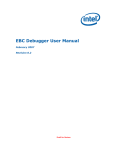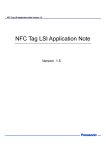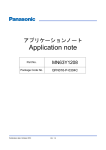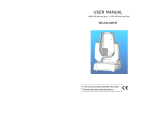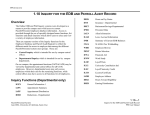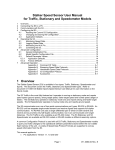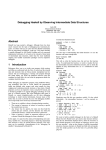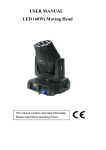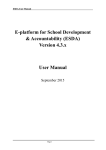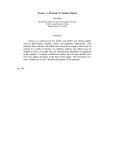Download EBC Debugger User Manual
Transcript
EBC Debugger User Manual
March 2007
Revision 0.21
Draft for Review
INFORMATION IN THIS DOCUMENT IS PROVIDED IN CONNECTION WITH INTEL® PRODUCTS. NO LICENSE, EXPRESS OR
IMPLIED, BY ESTOPPEL OR OTHERWISE, TO ANY INTELLECTUAL PROPERTY RIGHTS IS GRANTED BY THIS DOCUMENT. EXCEPT
AS PROVIDED IN INTEL’S TERMS AND CONDITIONS OF SALE FOR SUCH PRODUCTS, INTEL ASSUMES NO LIABILITY
WHATSOEVER, AND INTEL DISCLAIMS ANY EXPRESS OR IMPLIED WARRANTY, RELATING TO SALE AND/OR USE OF INTEL
PRODUCTS INCLUDING LIABILITY OR WARRANTIES RELATING TO FITNESS FOR A PARTICULAR PURPOSE, MERCHANTABILITY,
OR INFRINGEMENT OF ANY PATENT, COPYRIGHT OR OTHER INTELLECTUAL PROPERTY RIGHT. Intel products are not intended
for use in medical, life saving, or life sustaining applications.
Intel may make changes to specifications and product descriptions at any time, without notice.
Designers must not rely on the absence or characteristics of any features or instructions marked "reserved" or "undefined." Intel
reserves these for future definition and shall have no responsibility whatsoever for conflicts or incompatibilities arising from
future changes to them.
Contact your local Intel sales office or your distributor to obtain the latest specifications and before placing your product order.
Intel and the Intel logo are trademarks or registered trademarks of Intel Corporation or its subsidiaries in the United States and
other countries.
*Other names and brands may be claimed as the property of others.
Copyright © 2007, Intel Corporation. All rights reserved.
ii
Draft for Review
Contents
1
Introduction .....................................................................................................1
1.1
1.2
1.3
1.3.1
1.3.2
1.4
2
Getting Started.................................................................................................5
2.1
2.2
2.3
2.4
2.5
2.6
3
Overview ..............................................................................................1
Terms...................................................................................................1
Conventions used in this document ...........................................................2
Pseudo-code conventions ...........................................................2
Typographic conventions ............................................................2
Related Information................................................................................3
What is the EBC Debugger? .....................................................................5
Where is EBC Debugger ..........................................................................5
Prerequisite ...........................................................................................5
Load the EBC Debugger...........................................................................5
Run the EBC Debugger............................................................................6
A typical EBC Debug session ....................................................................6
EBC Debugger Command Description...................................................................9
3.1
3.1.1
3.1.2
3.2
3.2.1
3.2.3
Overview ..............................................................................................9
Command Summary ..................................................................9
Explanation of Command Description Layout ............................... 10
EBC Debugger Commands ..................................................................... 11
Execution class commands ....................................................... 11
G
............................................................................................ 11
T
............................................................................................ 12
P
............................................................................................ 13
O
............................................................................................ 14
Q
............................................................................................ 15
3.2.2
Break class commands............................................................. 16
BOC
............................................................................................ 16
BOCX
............................................................................................ 17
BOR
............................................................................................ 18
BOE
............................................................................................ 19
BOT
............................................................................................ 20
BOK
............................................................................................ 21
BL
............................................................................................ 22
BP
............................................................................................ 23
BC
............................................................................................ 24
BD
............................................................................................ 25
BE
............................................................................................ 26
Information class commands..................................................... 27
K
............................................................................................ 27
TRACE
............................................................................................ 28
R
............................................................................................ 29
L
............................................................................................ 30
SCOPE ............................................................................................ 31
DB, DW, DD, DQ.................................................................................. 32
Draft for Review
3.2.4
3.2.5
EB, EW, ED, EQ ................................................................................... 33
Symbol class commands .......................................................... 34
LN
............................................................................................ 34
LOADSYMBOL ...................................................................................... 36
UNLOADSYMBOL .................................................................................. 37
LOADCODE ......................................................................................... 38
UNLOADCODE ..................................................................................... 39
DISPLAYSYMBOL.................................................................................. 40
DISPLAYCODE ..................................................................................... 41
Other commands..................................................................... 42
H
............................................................................................ 42
Appendix A Configuring the EBC Debugger under EFI Shell ....................................................... 45
A.1
EBC Debugger Configuration............................................................................. 45
A.2
Where is EBC Debugger Configuration................................................................ 45
A.3
Command Summary........................................................................................ 45
A.3.1
Break class commands .................................................................................... 45
BOC
45
BOCX
47
BOR
48
BOE
49
BOT
50
BOK
51
Figures
Figure 1. EBC Debug session – step 1 ..................................................................7
Figure 2. EBC Debug session – step 2 ..................................................................8
Figure 3. EBC Debug session – step 3 ..................................................................8
Tables
Table 1. EBC Debugger Commands......................................................................9
Table 2. EBC Debugger Configuration Commands ................................................ 45
iv
Draft for Review
Revision History
Revision
Number
Description
Revision
Date
0.1
Initial release.
January 2007
0.2
Draft candidate
February 2007
Updated the document for the new features:
March 2007
0.21
-
-
Load symbol files from any file systems
-
-
Use the symbol name in BP, G, DB, EB commands
-
-
Add break on keyboard input feature
Draft for Review
v
vi
Draft for Review
1
Introduction
1.1
Overview
This document describes the information on how to use an EBC debugger on EFI
implementation. The following chapters include:
How to use an EBC debugger
Description for each EBC debugger command
1.2
Terms
The following terms are used throughout this document to describe varying aspects of
input localization:
Component
An executable image. Components defined in this specification support
one of the defined module types.
EFI
Generic term that refers to one of the versions of the EFI specification: EFI
1.02, EFI 1.10, UEFI 2.0, UEFI 2.1, or a later UEFI specification.
EFI 1.10 Specification
Intel Corporation published the Extensible Firmware Interface
Specification. Intel donated the EFI specification to the Unified EFI Forum,
and the UEFI now owns future updates of the EFI specification. See UEFI
Specifications.
GUID
Globally Unique Identifier. A 128-bit value used to name entities uniquely.
An individual without the help of a centralized authority can generate a
unique GUID. This allows the generation of names that will never conflict,
even among multiple, unrelated parties.
Module
A module is either an executable image or a library instance. For a list of
module types supported by this package, see module type.
Draft for Review
4B4B4BIntroduction
UEFI Application
An application that follows the UEFI specification. The only difference
between a UEFI application and a UEFI driver is that an application is
unloaded from memory when it exits regardless of return status, while a
driver that returns a successful return status is not unloaded when its
entry point exits.
UEFI Driver
A driver that follows the UEFI specification.
UEFI Specification Version 2.0
First version of the EFI specification released by The Unified EFI Forum.
This specification builds on the EFI 1.10 specification and transfers
ownership of the EFI specification from Intel to a non-profit, industry trade
organization.
UEFI Specification Version 2.1
Current version of the EFI specification released by the Unified EFI Forum.
The Unified EFI Forum
A non-profit collaborative trade organization formed to promote and
manage the UEFI standard. For more information, see www.uefi.org.
1.3
Conventions used in this document
This document uses the typographic and illustrative conventions described below.
1.3.1
Pseudo-code conventions
Pseudo code is presented to describe algorithms in a more concise form. None of the
algorithms in this document are intended to be compiled directly. The code is
presented at a level corresponding to the surrounding text.
In describing variables, a list is an unordered collection of homogeneous objects. A
queue is an ordered list of homogeneous objects. Unless otherwise noted, the ordering
is assumed to be First In First Out (FIFO).
Pseudo code is presented in a C-like format, using C conventions where appropriate.
The coding style, particularly the indentation style, is used for readability and does not
necessarily comply with an implementation of the Extensible Firmware Interface
Specification.
1.3.2
Typographic conventions
This document uses the typographic and illustrative conventions described below:
Plain text
2
The normal text typeface is used for the vast majority of the
descriptive text in a specification.
Draft for Review
Plain text (blue)
Any plain text that is underlined and in blue indicates an active
link to the cross-reference. Click on the word to follow the
hyperlink.
Bold
In text, a Bold typeface identifies a processor register name. In
other instances, a Bold typeface can be used as a running head
within a paragraph.
Italic
In text, an Italic typeface can be used as emphasis to introduce
a new term or to indicate a manual or specification name.
BOLD Monospace
Computer code, example code segments, and all prototype
code segments use a BOLD Monospace typeface with a dark red
color. These code listings normally appear in one or more
separate paragraphs, though words or segments can also be
embedded in a normal text paragraph.
Bold Monospace
Words in a Bold Monospace typeface that is underlined and in
blue indicate an active hyperlink to the code definition for that
function or type definition. Click on the word to follow the
hyperlink.
Italic
Monospace
In code or in text, words in Italic Monospace indicate
placeholder names for variable information that must be
supplied (i.e., arguments).
Plain Monospace
In code, words in a Plain Monospace typeface that is a dark red
color but is not bold or italicized indicate pseudo code or
example code. These code segments typically occur in one or
more separate paragraphs.
See the glossary sections in the EFI 1.10 Specification and in the EFI Documentation
help system for definitions of terms and abbreviations that are used in this document
or that might be useful in understanding the descriptions presented in this document.
See the references sections in the EFI 1.10 Specification and in the in the EFI
Documentation help system for a complete list of the additional documents and
specifications that are required or suggested for interpreting the information
presented in this document:
The EFI 1.10 Specification is available from the EFI web site
http://developer.intel.com/technology/efi/. The EFI Documentation help system is
available from the EFI web site
http://developer.intel.com/technology/efi/help/efidocs.htm.
1.4
Related Information
The following publications and sources of information may be useful, or are referred to
by this document:
Extensible Firmware Interface Specification, Version 1.10, Intel, 2001,
http://developer.intel.com/technology/efi.
Draft for Review
3
4B4B4BIntroduction
Unified Extensible Firmware Interface Specification, Version 2.0, Unified EFI, Inc,
2006, http://www.uefi.org.
Unified Extensible Firmware Interface Specification, Version 2.1, Unified EFI, Inc,
2007, http://www.uefi.org.
4
Draft for Review
2
Getting Started
2.1
What is the EBC Debugger?
The EBC Debugger is a tool that can help a user to debug an EBC driver or an EBC
application in the EFI shell environment.
The EBC Debugger is an EFI native (service) driver. It is an EBC interpreter with
debug ability.
2.2
Where is EBC Debugger
The EBC Debugger is on the CD in the \EbcDebugger\ directory. The included binaries
only support Intel® 64, IA-32, and Intel® Itanium® instruction set architectures.
2.3
Prerequisite
When the EBC Debugger is loaded, it will unload the existing EBC interpreter. So the
user should ensure that there are no other EBC interpreters loaded after that.
The EBC Debugger uses ConOut and ConIn as input and output interface. ConIn and
ConOut are required to operate the EBC debugger.
(Optional) In order to support symbolic debugging, the user needs to use DEBUG
version of the driver and provide the .MAP file from the building of the driver.
The .MAP file could be put into any file system. The EBC Debugger searches the .MAP
file on all files systems automatically.
(Optional) In order to support source level debugging, the user need to use DEBUG
version driver and provide both the .MAP file and the .COD files from the building of
the driver. The .MAP and .COD files could be put into any file system. The EBC
Debugger searches the .MAP and .COD files on all file systems automatically.
If two source files have same name, then they will have COD files with the same
name. This is not supported.
2.4
Load the EBC Debugger
As EBC Debugger is a driver, there are 2 ways to load it.
The user can load it manually by using shell command "load EbcDebugger.efi."
The user can build the EbcDebugger.efi to the firmware image, so it will be loaded
automatically in system booting.
Draft for Review
Configuring the EBC Debugger under EFI Shell
2.5
Run the EBC Debugger
If the EBC debugger is loaded it will automatically start when it meets one of the
following conditions:
An EBC image starts.
Native-to-EBC thunk code is called.
An EBC exception happens. For example, EBC Breakpoint exception.
When the EBC debugger starts, the EBC debugger prompt will be displayed. User can
then use EBC debugger commands in this shell-like environment.
2.6
A typical EBC Debug session
an example of a typical EBC debug session follows. EbcTest.efi is an EBC driver,
EbcTest.map is the .MAP file, EbcTest.cod, and EbcTestSub.cod are the .COD files.
These are located in the CD directory \EbcTest\.
The steps followed by the user are:
1) On the target system, boot an EFI system.
2) Get the debugger loaded into memory. (see 2.4)
3) Copy all the .MAP file and .COD file to 1st file system, for example: fsnt0:\ebctest\
4) Load the driver (load ebctest.efi). This causes the EBC debugger prompt to display
with the interpreter stopped at the EBC driver’s entry point. (see 2.5)
5) Load the symbol files at Debugger command prompt.
a)
6
type "loadsymbol ebctest\ebctest.map a" (the "a" switch causes the
debugger to load all .cod file in same directory See Figure 1.
Draft for Review
Figure 1. EBC Debug session – step 1
6) The user will list all symbols with the ln command and fine the address of
EfiMain() routing (0x8D2E51A in this case) see Figure 2.
Draft for Review
7
Configuring the EBC Debugger under EFI Shell
Figure 2. EBC Debug session – step 2
7) The user allows the program to run freely until the EfiMain() routine (use the
command "G til 8d2e51a"). The program execution is now at the Image’s Entry
point. The user can set breakpoints and debug in their code. See Figure 3.
Figure 3. EBC Debug session – step 3
The user can also set breakpoints in the source code using the EFI_BREAKPOINT()
macro, which is defined as _break(3) in debug builds. This will result in the EBC
debugger stopping at that place in the code.
Please see Chapter 3 for details on the commands of the EBC debugger.
8
Draft for Review
3
EBC Debugger Command
Description
3.1
Overview
3.1.1
Command Summary
Table 1 lists all EBC debugger commands.
Table 1. EBC Debugger Commands
Class
Command
Description
Execution
G
continue to run the program.
T
step into.
P
step over.
O
step out.
Q
reset the debugger to default value and go.
BOC
break on CALL.
BOCX
break on CALLEX.
BOR
break on RET.
BOE
break on Driver Entrypoint.
BOT
break on Native Thunk.
BOK
break on Keyboard Input
BL
breakpoint list
BP
breakpoint set
BC
breakpoint clear
BD
breakpoint disable
BE
breakpoint enable
K
show/clear call-stack
TRACE
show/clear trace instruction branch
R
display/modify register
L
show/load instruction assembly count
SCOPE
load scope address
DB, DW, DD, DQ
display memory
Break
Information
Draft for Review
9
Configuring the EBC Debugger under EFI Shell
Symbol
Other
3.1.2
EB, EW, ED, EQ
modify memory
LN
list the symbol
LOADSYMBOL
load the symbol file
UNLOADSYMBOL
unload the symbol file
LOADCODE
load the code file
UNLOADCODE
unload the code file
DISPLAYSYMBOL
disable/enable the symbol output
DISPLAYCODE
disable/enable the source code only output
H
help
Explanation of Command Description Layout
The description of each command is composed of four sections: Summary, Usage,
Function Key, and Description.
Summary is a brief explanation of the function of the command. Usage describes how
the command is used. Function Key is the fast way to run this command.
Description describes the details of the command.
10
Draft for Review
3.2
EBC Debugger Commands
3.2.1
Execution class commands
G
Summary
continue to run the program.
Usage
G [til <Address|Symbol>]
(No Argument) - It means continue run the program.
til
- It means continuing run the program till IP is the
Address.
<Address>
- The hexadecimal address user wants to break at.
<Symbol>
- The symbol name for target address user want to break
at. It has following format [MapFileName:]SymbolName.
Function Key
[F5]
Description
Use of the go command causes the debugger not to interrupt execution of the EBC
image. The debugger will only break execution of the interpreter if it encounters an
exception (including an EBC breakpoint).
Examples
Examples:
* To continue run the program:
EDB > G
* To continue run the program until IP is 8D2F51A:
EDB > G TIL 8D2F51A
Break on GoTil
[EfiMain]:
08D2F51A: 60 00 70 80
MOVqw
R0, R0(-0,-122)
;117 ; {
08D2F51E: 77 58 58 00 34
08D2F523: 12
MOVIww
@R0(+0,+88), 4660
;118 ;
UINT16 test = 0x1234;
08D2F524: 72 87 01 12
MOVnw
R7, @R0(+1,+128)
08D2F528: 72 F7 85 21
MOVnw
R7, @R7(+5,+24)
;121 ;
EFI_STATUS Status;
;121 ;
;121 ;
SystemTable->ConOut->OutString (
08D2F52C: 72 84 01 12
MOVnw
R4, @R0(+1,+128)
Draft for Review
11
Configuring the EBC Debugger under EFI Shell
T
Summary
step into.
Usage
T
(No Argument)
Function Key
[F8]
Description
The step into command will cause the EBC debugger to step a single instruction. If the
instruction is a call to internal code (CALL), then the debugger will break at the new
function CALL.
Examples
Examples:
* To step into the program:
EDB > T
12
Draft for Review
P
Summary
step over.
Usage
P
(No Argument)
Function Key
[F10]
Description
The step over command causes the EBC debugger to step a single instruction. If the
instruction is a call to internal code (CALL), then the external call is made and the
debugger breaks at the instruction following the CALL.
Examples
Examples:
* To step over the program:
EDB > P
Draft for Review
13
Configuring the EBC Debugger under EFI Shell
O
Summary
step out.
Usage
O
(No Argument)
Function Key
[F11]
Description
The step out command causes the EBC debugger to step out function calls. The
function executes, but the debugger stops after the called function returns.
Examples
Examples:
* To step out the program:
EDB > O
14
Draft for Review
Q
Summary
reset the debugger to default value and go.
Usage
Q
(No Argument)
Function Key
(None)
Description
The quit command will reset the debugger to default value and go.
Examples
Examples:
* To reset the debugger to default value and go:
EDB > Q
Draft for Review
15
Configuring the EBC Debugger under EFI Shell
3.2.2
Break class commands
BOC
Summary
break on CALL.
Usage
BOC [on|off]
(No Argument) - show current state
on
- enable break-on-call
off
- disable break-on-call
Function Key
(None)
Description
Enabling break-on-call will cause the debugger to halt execution and display the
debugger prompt prior to executing any EBC CALL (to EBC) instructions.
Examples
Examples:
* To enable break-on-CALL:
EDB > BOC ON
* To show the current state:
EDB > BOC
BOC ON
16
Draft for Review
BOCX
Summary
break on CALLEX.
Usage
BOCX [on|off]
(No Argument) - show current state
on
- enable break-on-callex
off
- disable break-on-callex
Function Key
(None)
Description
Enabling break-on-callex causes the debugger to halt execution and display the
debugger prompt prior to executing EBC CALLEX (thunk out) instructions.
Examples
Examples:
* To enable break-on-CALLEX:
EDB > BOCX ON
* To show the current state:
EDB > BOCX
BOCX ON
Draft for Review
17
Configuring the EBC Debugger under EFI Shell
BOR
Summary
break on RET.
Usage
BOR [on|off]
(No Argument) - show current state
on
- enable break-on-return
off
- disable break-on-return
Function Key
(None)
Description
Enabling break-on-return will cause the debugger to halt execution and display the
debugger prompt prior to executing EBC RET instructions.
Examples
Examples:
* To enable break-on-RET:
EDB > BOR ON
* To show the current state:
EDB > BOR
BOR ON
18
Draft for Review
BOE
Summary
break on Driver Entrypoint.
Usage
BOE [on|off]
(No Argument) - show current state
on
- enable break-on-entrypoint
off
- disable break-on-entrypoint
Function Key
(None)
Description
Enabling break-on-entrypoint causes the debugger to halt execution and display the
debugger prompt prior to start a driver entry point. (Default is on).
Examples
Examples:
* To disable break-on-entrypoint:
EDB > BOE OFF
* To show the current state:
EDB > BOE
BOE OFF
Draft for Review
19
Configuring the EBC Debugger under EFI Shell
BOT
Summary
break on Native Thunk.
Usage
BOT [on|off]
(No Argument) - show current state
on
- enable break-on-thunk
off
- disable break-on-thunk
Function Key
(None)
Description
Enabling break-on-thunk will cause the debugger to halt execution and display the
debugger prompt prior to start native call EBC thunk. (Default is on)
Examples
Examples:
* To enable break-on-thunk:
EDB > BOT ON
* To show the current state:
EDB > BOT
BOT ON
20
Draft for Review
BOK
Summary
break on Keyboard Input.
Usage
BOK [on|off]
(No Argument) - show current state
on
- enable break-on-key
off
- disable break-on-key
Function Key
(None)
Description
Enabling break-on-key will cause the debugger to halt execution and display the
debugger prompt after press any key. It is useful when an EBC driver has an infinite
loop.
Examples
Examples:
* To enable break-on-key:
EDB > BOK ON
* To show the current state:
EDB > BOK
BOK ON
Draft for Review
21
Configuring the EBC Debugger under EFI Shell
BL
Summary
breakpoint list.
Usage
BL
(No Argument) - show the state for current breakpoint
Function Key
(None)
Description
List Breakpoint
Examples
Examples:
* To list breakpoint:
EDB > BL
Breakpoint:
Index
Address
Status
======= ================== ========
0
0x0000000008D2F52C
*
22
Draft for Review
BP
Summary
breakpoint set.
Usage
BP <Address|Symbol>
<Address> - Hexical breakpoint address
<Symbol> - Symbol name for breakpoint address. It has following format
[MapFileName:]SymbolName.
Function Key
(None)
Description
Set Breakpoint
Examples
Examples:
* To set breakpoint:
EDB > BP 8D2E52C
Draft for Review
23
Configuring the EBC Debugger under EFI Shell
BC
Summary
breakpoint clear.
Usage
BC <Index>|*
<Index>
*
- Decimal breakpoint index, which can be got from BL command
- For all the breakpoint
Function Key
(None)
Description
Clear Breakpoint
Examples
Examples:
* To clear breakpoint:
EDB > BC 0
24
Draft for Review
BD
Summary
breakpoint disable.
Usage
BD <Index>|*
<Index>
*
- Decimal breakpoint index, which can be got from BL command
- For all the breakpoint
Function Key
(None)
Description
Disable Breakpoint
Examples
Examples:
* To disable breakpoint:
EDB > BD 0
Draft for Review
25
Configuring the EBC Debugger under EFI Shell
BE
Summary
breakpoint enable.
Usage
BE <Index>|*
<Index>
*
- Decimal breakpoint index, which can be got from BL command
- For all the breakpoint
Function Key
(None)
Description
Enable Breakpoint
Examples
Examples:
* To enable breakpoint:
EDB > BE 0
26
Draft for Review
3.2.3
Information class commands
K
Summary
show/clear call-stack.
Usage
K [p [<ParameterNum>]|c]
(No Argument)
p
ParameterNum
as max
c
- Show current call-stack
- Show current call-stack with parameters
- Decimal call-stack parameters number, 8 by default, 16
- Clear current call-stack
Function Key
(None)
Description
The call-stack command will show or clear the current call-stack.
Examples
Examples:
* To show the current call-stack:
EDB > K
Call-Stack (TOP):
Caller
Callee
================== ==================
0x0000000008D2F55A 0x0000000008D2F600
0x0000000008D2F750 0x0000000008D2F51A
0x00000000FFFFFFFF 0x0000000008D2F620
Name
========
TestSubRoutineSub()
EfiMain()
EfiStart()
* To show the current call-stack with parameter:
EDB > K P 2
Call-Stack (TOP):
Caller
Callee
Name
================== ================== ========
0x0000000008D2F55A 0x0000000008D2F600 TestSubRoutineSub()
Parameter Address (0x08B26F24) (
0x00000001, 0x00000005
)
0x0000000008D2F750 0x0000000008D2F51A EfiMain()
Parameter Address (0x08B26FA4) (
0x08D2D710, 0x04C6FE90
)
0x00000000FFFFFFFF 0x0000000008D2F620 EfiStart()
Parameter Address (0x08B26FF4) (
0xAFAFAFAF, 0xAFAFAFAF
)
Draft for Review
27
Configuring the EBC Debugger under EFI Shell
TRACE
Summary
show/clear trace instruction branch.
Usage
TRACE [c]
(No Argument) - Show current instrcution branch
c
- Clear current instruction branch
Function Key
(None)
Description
The trace command will show or clear the latest instruction branch.
Examples
Examples:
* To show the current instruction branch:
EDB > TRACE
Instruction Trace (->Latest):
Source Addr
Destination Addr
Type
================== ================== ========
0x0000000008D2F652 0x0000000008D2F6CE (JMP8)
0x0000000008D2F6E8 0x0000000008D2F6EA (JMP8)
0x0000000008D2F702 0x0000000008D2F704 (JMP8)
0x0000000008D2F70C 0x0000000008D2F72A (JMP8)
0x0000000008D2F744 0x0000000008D2F704 (JMP8)
0x0000000008D2F70C 0x0000000008D2F70E (JMP8)
0x0000000008D2F728 0x0000000008D2F800 (CALL)
28
Draft for Review
R
Summary
display/modify register.
Usage
R [<Register> <Value>]
(No Argument) - Display all registers
<Register>
- EBC VM register name (R0~R7, Flags, ControlFlags, and
IP
<Value>
- The Hexical value of register
Function Key
[F2]
Description
The register command is used to display or modify the contents of EBC VM registers.
(R0~R7, Flags, IP).
Examples
Examples:
* To show the current register:
EDB > R
R0 – 0x0000000008b26F14, R1 – 0x000000000000
R2 – 0x0000000008b26F14, R3 – 0x000000000000
R4 – 0x0000000008b26F14, R5 – 0x000000000000
R6 – 0x0000000008b26F14, R7 – 0x000000000000
Flags – 0x0000000000000001, ControlFlags – 0x0000000000000000
Ip – 0x0000000008D2F61A
* To update the current register:
EDB > R R1 1
Draft for Review
29
Configuring the EBC Debugger under EFI Shell
L
Summary
show/load instruction assembly count.
Usage
L [<Count>]
(No Argument) - List current assembly code
<Count>
- The decimal instruction assembly count
Function Key
[F4]
Description
The list assembly command will disassemble instructions starting with the current EBC
VM instruction pointer. (by default 5 instructions).
Examples
Examples:
* To show the current assembly:
EDB > L
30
Draft for Review
SCOPE
Summary
load scope address.
Usage
SCOPE <Address|Symbol>
<Address> - The Hexical address where user wants to see the assembly
code
<Symbol> - Symbol name for scope address. It has following format
[MapFileName:]SymbolName.
Function Key
(None)
Description
The list assembly command will disassemble instructions starting with the current EBC
VM instruction pointer. (by default 5 instructions).
Examples
Examples:
* To load the scope address:
EDB > SCOPE 8D2F61A
Draft for Review
31
Configuring the EBC Debugger under EFI Shell
DB, DW, DD, DQ
Summary
display memory.
Usage
D[B|W|D|Q] <Address|Symbol> [<Count>]
<Address> - The hexical memory address
<Symbol> - Symbol name for memory address. It has following format
[MapFileName:]SymbolName.
<Count>
- The hexical memory count (not set means 1)
Generally only the global C variables are stored in .MAP file. For the local variables or static
variables, user still needs to access them from memory address.
Function Key
(None)
Description
Display BYTES/WORDS/DWORDS/QWORDS Memory.
Examples
Examples:
* To show the memory:
EDB > DD 8D2E000 8
08D2E000: 30726670 00000000 08DAAA1C 08D2E088
08D2E010: AFAFAFAF AFAFAFAF AFAFAFAF AFAFAFAF
32
Draft for Review
EB, EW, ED, EQ
Summary
modify memory.
Usage
E[B|W|D|Q] <Address|Symbol> <Value>
<Address> - The hexical memory address
<Symbol> - Symbol name for memory address. It has following format
[MapFileName:]SymbolName.
<Value>
- The hexical memory value
Note: Generally only the global C variables are stored in .MAP file. For the local variables or
static variables, user still needs to access them from memory address.
Function Key
(None)
Description
Enter BYTES/WORDS/DWORDS/QWORDS Memory.
Examples
Examples:
* To modify the memory:
EDB > ED 8D2FC78 8
Draft for Review
33
Configuring the EBC Debugger under EFI Shell
3.2.4
Symbol class commands
LN
Summary
list the symbol.
Usage
LN [[F <SymbolFile>] [S <Symbol>]] | <Address>
(No Argument)
F <SymbolFile>
S <Symbol>
<Address>
the symbol for.
-
List all the symbol
List the symbol in this symbol file only
List this symbol only
The hexical memory address, which user want to find
Function Key
(None)
Description
The show symbol command will list all the current symbol. It can list the symbol in
one symbol file, or list the same symbol in all the files. It can also list the symbol
according to nearest address. (In the result - type field, F means Function, SF means
Static Function, GV means Global Variable)
34
Draft for Review
Examples
Examples:
* To list the symbol:
EDB > LN
Symbol File Name: ebctest.map
Address
Type Symbol
========== ==== ========
0x08D2F442 ( F) TestSubRoutine (EbcTest.obj)
0x08D2F51A ( F) EfiMain (EbcTest.obj)
0x08D2F600 ( F) TestSubRoutineSub (EbcTest.obj)
0x08D2F620 ( F) EfiStart (EbcLib:EbcLib.obj)
0x08D2F800 ( F)
varbss_init_C:\efi_src\TIANO\Edk\Sample\Universal\Ebc\Dxe\EbcTest\EbcTest
$c45b6d8ef (EbcTest.obj)
0x08D2F820 ( F)
varbss_init_C:\efi_src\TIANO\Edk\Sample\Universal\Ebc\Dxe\EbcTest\EbcTest
Sub$c45b6d8ef (EbcTestSub.obj)
0x08D2FA00 (GV) CrtThunkBegin (EbcLib:EbcLib.obj)
0x08D2FA04 (GV) CrtThunkEnd (EbcLib:EbcLib.obj)
0x08D2FA08 (GV) CrtBegin (EbcLib:EbcLib.obj)
0x08D2FA14 (GV) CrtEnd (EbcLib:EbcLib.obj)
0x08D2FC70 (GV) TestStr (EbcTest.obj)
0x08D2FC78 (GV) TestVariable1 (EbcTest.obj)
0x08D2FC80 (GV) TestSubVariableSub (EbcTestSub.obj)
0x08D2F400 (SF) TestSubRoutine2 (EbcTest.obj)
* To list the nearest symbol:
EDB > LN 8d2f500
Symbol at Address not found, print nearest one!
Symbol File Name: ebctest.map
Address
Type Symbol
========== ==== ========
0x08D2F51A ( F) EfiMain
* To list the symbol with name:
EDB > LN S EfiMain
Symbol File Name: ebctest.map
Address
Type Symbol
========== ==== ========
0x08D2F51A ( F) EfiMain (EbcTest.obj)
Draft for Review
35
Configuring the EBC Debugger under EFI Shell
LOADSYMBOL
Summary
load the symbol file.
Usage
LOADSYMBOL <SymbolFile> [a]
SymbolFile - The EBC symbol file (Its name should be XXX.MAP)
a
- Automatically load code files in the same dir
Function Key
(None)
Description
The load symbol command will load the ebc map file. Then it parses the function
name and global variable, and the print real name when do the disassembly. (Symbol
file name should be XXX.MAP).
Examples
Examples:
* To load the symbol:
EDB > LOADSYMBOL ebctest\ebctest.map
* To load the symbol and related code:
EDB > LOADSYMBOL ebctest\ebctest.map a
36
Draft for Review
UNLOADSYMBOL
Summary
unload the symbol file.
Usage
UNLOADSYMBOL <SymbolFile> [a]
SymbolFile - The EBC symbol file (Its name should be XXX.MAP)
Function Key
(None)
Description
The unload symbol command will unload the ebc map and cod file. After that the
name will not be print.
Examples
Examples:
* To unload the symbol:
EDB > UNLOADSYMBOL ebctest.map
Draft for Review
37
Configuring the EBC Debugger under EFI Shell
LOADCODE
Summary
load the code file.
Usage
LOADCODE <CodeFile> <SymbolFile>
CodeFile
- The EBC code file (Its name should be XXX.COD)
SymbolFile - The EBC symbol file (Its name should be XXX.MAP)
Function Key
(None)
Description
The load code command will load the ebc cod file. Then it parses the cod file, and the
print source code when do the disassembly. (Code file name should be XXX.COD).
Examples
Examples:
* To load the code:
EDB > LOADCODE ebctest\ebctest.cod ebctest.map
38
Draft for Review
UNLOADCODE
Summary
unload the code file.
Usage
UNLOADCODE <CodeFile> <SymbolFile>
CodeFile
- The EBC code file (Its name should be XXX.COD)
SymbolFile - The EBC symbol file (Its name should be XXX.MAP)
Function Key
(None)
Description
The unload code command will unload the ebc cod file. After that the source code will
not be print.
Examples
Examples:
* To unload the code:
EDB > UNLOADCODE ebctest\ebctest.cod ebctest.map
Draft for Review
39
Configuring the EBC Debugger under EFI Shell
DISPLAYSYMBOL
Summary
disable/enable the symbol output.
Usage
DISPLAYSYMBOL [on|off]
(No Argument) - swtich symbol output state to another one
on
- enable symbol output
off
- disable symbol output
Function Key
[F3]
Description
The display symbol command will configure the symbol show or not-show when
disassembly.
Examples
Examples:
* To siwtch display symbol:
EDB > DISPLAYSYMBOL
40
Draft for Review
DISPLAYCODE
Summary
disable/enable the source code only output.
Usage
DISPLAYCODE [on|off]
(No Argument) - swtich source only output state to another one
on
- enable source only output
off
- disable source only output
Function Key
[F6]
Description
The display code command will configure the source code only show or miscellaneous
source code with assembly.
Examples
Examples:
* To siwtch display code:
EDB > DISPLAYCODE
Draft for Review
41
Configuring the EBC Debugger under EFI Shell
3.2.5
Other commands
H
Summary
Help.
Usage
H [<Command>]
(No Argument) – show help information for all command
Command
- show detail help information for this command
Function Key
[F1]
Description
The help command will print help information for each command.
42
Draft for Review
Examples
Examples:
•
To print help:
EDB > H
Execution:
G/[F5]
T/[F8]
P/[F10]
O/[F11]
Q
Break:
BO[C|CX|R|E|T|K]
Thunk/Key
B[L|P|C|D|E]
Information:
K
TRACE
R/[F2]
L/[F4]
SCOPE
[D|E][B|W|D|Q]
Symbol:
LN
[UN]LOADSYMBOL
[UN]LOADCODE
DISPLAYSYMBOL/[F3]
DISPLAYCODE/[F6]
-
continue to run the program
step into
step over
step out
reset the debugger to default value and go
- break on CALL/CALLEX/RET/Entrypoint/Native
- breakpoint list/set/clear/disable/enable
-
show/clear call-stack
show/clear trace instruction branch
display/modify register
show/load instruction assembly count
load scope address
display/modify memory
-
list the symbol
load/unload the symbol file
load/unload the code file
disable/enable the symbol output
disable/enable the source code only output
EDB > H G
The go command is used to cause the debugger to not interrupt
execution of the EBC image. The debugger will only break execution of the
interpreter if an exception is encountered (including an EBC breakpoint).
G [til <Address|Symbol>]
(No Argument) - It means continue run the program.
til
- It means continuing run the program till IP is the
Address.
<Address>
- The hexical address user want to break at.
<Symbol>
- The symbol name for target address user want to break
at. It has following format [MapFileName:]SymbolName.
Draft for Review
43
Configuring the EBC Debugger under EFI Shell
44
Draft for Review
Appendix A
Configuring the EBC Debugger
under EFI Shell
A.1
EBC Debugger Configuration
Sometimes the user may want to disable all Break conditions and just let the EBC
image run. How can this be done and then reversed at the user’s discretion. The EFI
shell application EbcDebuggerConfig acomplishes this.
A.2
Where is EBC Debugger Configuration
EBC Debugger Configuration is on the CD in \EbcDebuggerConfig\ directory. The
binaries only support Intel® 64, IA-32, and Intel® Itanium® architectures.
A.3
Command Summary
Table 2 lists all EBC debugger configuration commands.
Table 2. EBC Debugger Configuration Commands
Class
Command
Description
Break
BOC
break on CALL.
BOCX
break on CALLEX.
BOR
break on RET.
BOE
break on Driver Entrypoint.
BOT
break on Native Thunk.
BOK
break on Keyboard Input
Draft for Review
45
Configuring the EBC Debugger under EFI Shell
A.3.1 Break class commands
BOC
Summary
break on CALL.
Usage
BOC [on|off]
(No Argument) - show current state
on
- enable break-on-call
off
- disable break-on-call
Description
Enabling break-on-call will cause the debugger to halt execution and display the
debugger prompt prior to executing any EBC CALL (to EBC) instructions.
Examples
Examples:
* To enable break-on-CALL:
Shell> EDBCFG BOC ON
* To show the current state:
Shell> EDBCFG BOC
BOC ON
46
Draft for Review
BOCX
Summary
break on CALLEX.
Usage
BOCX [on|off]
(No Argument) - show current state
on
- enable break-on-callex
off
- disable break-on-callex
Description
Enabling break-on-callex will cause the debugger to halt execution and display the
debugger prompt prior to executing EBC CALLEX (thunk out) instructions.
Examples
Examples:
* To enable break-on-CALLEX:
Shell> EDBCFG BOCX ON
* To show the current state:
Shell> EDBCFG BOCX
BOCX ON
Draft for Review
47
Configuring the EBC Debugger under EFI Shell
BOR
Summary
break on RET.
Usage
BOR [on|off]
(No Argument) - show current state
on
- enable break-on-return
off
- disable break-on-return
Description
Enabling break-on-return will cause the debugger to halt execution and display the
debugger prompt prior to executing EBC RET instructions.
Examples
Examples:
* To enable break-on-RET:
Shell> EDBCFG BOR ON
* To show the current state:
Shell> EDBCFG BOR
BOR ON
48
Draft for Review
BOE
Summary
break on Driver Entrypoint.
Usage
BOE [on|off]
(No Argument) - show current state
on
- enable break-on-entrypoint
off
- disable break-on-entrypoint
Description
Enabling break-on-entrypoint will cause the debugger to halt execution and display
the debugger prompt prior to start a driver entry point. (Default is on).
Examples
Examples:
* To disable break-on-entrypoint:
Shell> EDBCFG BOE OFF
* To show the current state:
Shell> EDBCFG BOE
BOE OFF
Draft for Review
49
Configuring the EBC Debugger under EFI Shell
BOT
Summary
break on Native Thunk.
Usage
BOT [on|off]
(No Argument) - show current state
on
- enable break-on-thunk
off
- disable break-on-thunk
Description
Enabling break-on-thunk will cause the debugger to halt execution and display the
debugger prompt prior to start native call EBC thunk. (Default is on)
Examples
Examples:
* To enable break-on-thunk:
Shell> EDBCFG BOT ON
* To show the current state:
Shell> EDBCFG BOT
BOT ON
50
Draft for Review
BOK
Summary
break on Keyboard Input.
Usage
BOK [on|off]
(No Argument) - show current state
on
- enable break-on-key
off
- disable break-on-key
Description
Enabling break-on-key will cause the debugger to halt execution and display the
debugger prompt after press any key. It is useful when an EBC driver has an infinite
loop.
Examples
Examples:
* To enable break-on-key:
Shell> EDBCFG BOK ON
* To show the current state:
Shell> EDBCFG BOK
BOK ON
Draft for Review
51

























































